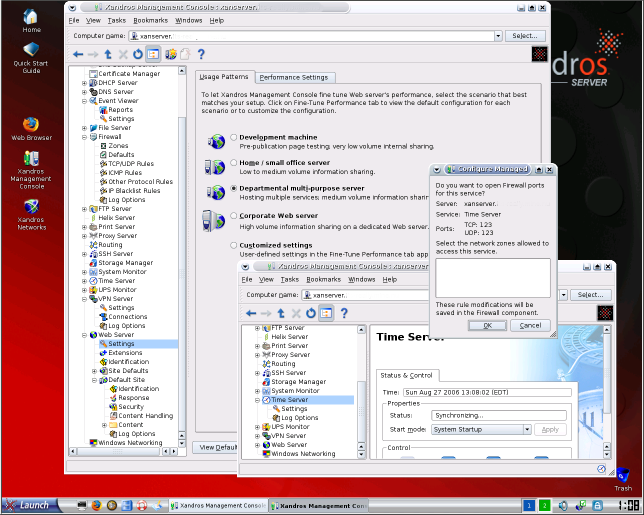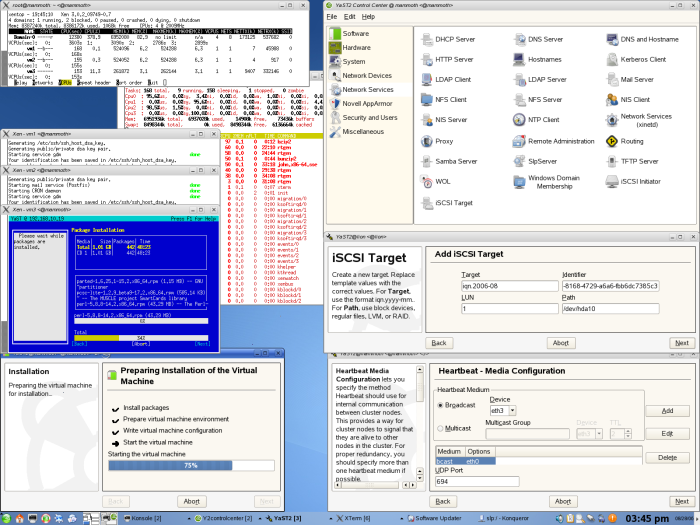The master and the apprentice
Dirk Wetter, Dr. Wetter IT-Consulting
This extended report is result of the research and review work done on the recently released Suse Linux Enterprise 10. Part of it is published in the German iX magazine [1,2], known for its in-depth reviews. This article included a few days testing in a lab scenario which we use for paid and other system research, too.Feel free to link this article if you find the information useful or send us an e-mail. However respect the copyright (see info on bottom of page).
Enduring teething troubles after the redesign of the higher level
packet management ZLM/ZMD made it necessary to delay the
general availability of (Open)Suse 10.1 and as a consequence also
the product internally developed from it: Suse
Linux Enterprise Server 10. SLES 10 is Suse's/Novell's fourth (SLES 7 throught 9) enterprise
server distribution. The predecessor SLES 9, released two years ago,
was despite the fact that kernel 2.6 was by that time relatively new,
known to be stable and made overall
a good
impression.
Recently joined the Linux server market
has Xandros with their Business Server. It is a good chance of comparing what a new born server
distribution has to offer as opposed to the veteran Suse/Novell.
The market of Linux in the enterprise
Competition for the established Linux enterprise distributors like Novell/Suse as well as Red Hat is getting tougher: Looking at the server market segment there might be still customers migrating to Linux, however since a little bit more than year there are more competitors around offering a server Unix at no costs: A while back Unix grandfather Sun has finally decided to give up its zig-zag course for the PC platform, so that nowadays Solaris/x86 and Solaris/x64 are alternatives to run on cheap PC hardware, if supported. Despite the assumption that nowadays new operating systems don't make quantum leaps, Solaris 10 emerged with a bunch of new features. Recently it included the innovative file system ZFS (Solaris 10 6/06) and e.g. a virtualization technique named zones/containers which is similar to BSD jails. Most of the security and recommended patches in Solaris are for free, for phone and e-mail support of course one has to pay for. To a certain extend this reminds on the rookie in the field of Linux server distributions: Ubuntu 6.06 LTS. The relatively new distribution from South Africa is free, so are the updates, only for support you have to spare some Rand/Isle of Man pounds. LTS stands for Long Term Support: Ubuntu guarantees 5 years software maintenance for server packages, 3 years for desktop. Patches are distributed quickly, in the last time maybe too fast.
There's not so much to say about the well established Novell/Suse and their main rival Red Hat. Both have a freely available community product with 15 to 24 months lifetime and half year release cycle – name confusions aside Suse's version is normally named OpenSuse, Red Hat's Fedora Core. The short life time makes it not reasonable to use it for the enterprise where 2 years or even less is not enough. Every third to fourth iteration of the community distribution serves internally as a development basis for Red Hat's or Novell's enterprise product having up to seven years lifetime. Simultaneously to the – or in the case of Red Hat variety of – server product(s), both of the vendors sell a stripped down version without server functionality for the desktop. Novell's recent name for it is Suse Linux Enterprise Desktop (SLED), Red Hat's Red Hat Workstation (WS). Opposed to Solaris or Ubuntu access to both the vendors portals providing maintenance and security patches costs money. The ISO images however are freely available for evaluation by registering with an e-mail address, giving you time-limited access to patches, Red Hat e.g. is granting 60 days.

|
| Picture 2: Xandros management console: xMC |
Opposed to those Linux "oldies" with more than a decade experience,
Xandros (the company) is relatively new, their server product is only
a few months old.
The Canadian based Linux firm headquartered
in Ottawa was started in 2001, founded by purchase of the Corel Linux
Desktop division. The resulting desktop product Xandros Desktop
– advertised with a four-click-installation – made a good
impression during a comparison of enterprise Linux desktop distribution
in 2004 [3]. Their first server product was
released in the beginning of May 2006. So, after reviewing
the Xandros desktop in 2004, it was more or less an obligation to review
Xandros' server product as well.
Lab environment: installation
For the research done in the lab there were a couple of computers available: In the old-but-still-good-IA32 category there were three PCs with 0.5 to 1.5 megs RAM and a CPU horsepower between 2 and 2.8 GHz available. Also an older IBM Thinkpad with 1 GB of memory, internal 802.11a and bluetooth was supposed to get a desktop installation with SLED 10. For the major part of the test however heavy Opteron iron equipped with plentiful memory was waiting for the SLES and Xandros packages to be installed. For detailed specs of this piece of server hardware, see Under the hood (at the right hand side on pge 3).
Novell's enterprise variants SLES and SLED – from now on titled as SLE (Suse Linux Enterprise) – were given birth via PXE and TFTP-boot. With one exception (see below) the installation of SLE was performed via NFS in the Gigabit network in the lab. No use of automated installation was made, however amongst the three possibilities Novell provides for remote installations (SSH, VNC, serial) by providing the right append option to the boot kernel remote installation of SLES via ssh (usessh=1 sshpassword=mysecret) was chosen. For SLED however due to a bug or missing feature, also present e.g. in Suse 10.1, it's not feasible to install the desktop variant remotely: First if you try to, during installation you have to set the runlevel explicitly to 5. In addition after the installation is finished one has to configure X manually, by means of the config tool sax2.
The Xandros server doesn't provide any means to perform the installation over the network, using not the physical console or any way of automate installations.
Lab environment: network scenario
Novell's server and desktop were supposed to be integrated into the lab environment: An existing OpenLDAP server under (Open)Suse 10.1 were authenticating test users via LDAPv3 and SSL. The very same piece of hard- and software was serving home and data directories via NFSv3 which every "candidate" was supposed to mount via local automounter maps. Fixed IP addresses and network settings were handed out by the DHCP server, in addition also IP addresses of the NTP servers using DHCP-options. For central syslogs, root and user e-mails there was another server. A CUPS server was broadcasting its queues. Since with the exception of the DHCP settings for the laptop this environment doesn't make sense, it was set up with local data only.
Without spoiling too much of the story: During the test it turned out that Xandros' first server shot would be more more a sparring partner than a competitive opponent to SLES which according to Novell is working on SGIs 1024 processor monsters^W machines (Altix). After confronting German sales and marketing with some issues encountered, it became clear that the server from Canada is more targetted at SMEs. Thus the 1:1 comparison with SLES has to be postponed. Rumors are around that Xandros seems to work on an advanced server which will compete better. The result of this research on Xandros' server you can find in the box What lies ahead on the right hand side of page 4.
